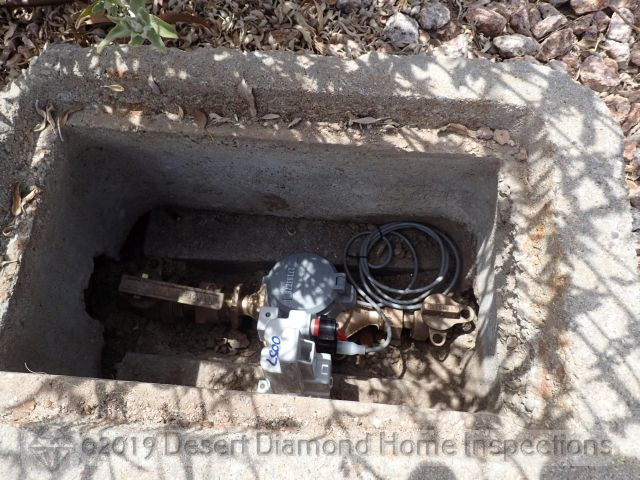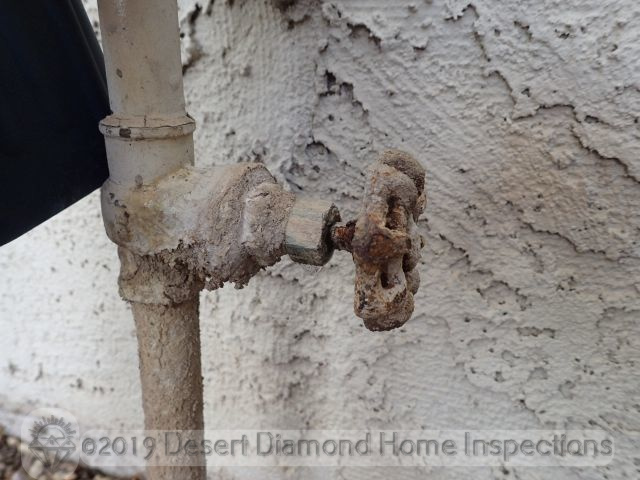Testing water shut-offs is the fifth article in our series of top 10 home maintenance tips. These tips are based on our experience from inspecting homes in Tucson where we see certain issues on a regular basis. Issues that could have been prevented with some easy and affordable proactive maintenance. Proactive home maintenance helps prevent unpleasant surprises and major damage and keeps maintenance and repair costs down. We hope you find these tips helpful and use them to keep your home in good shape.
Testing water shut-offs in your home
Our fifth home maintenance tip deals with testing water shut-offs. Your house has many valves to shut off the water in case something breaks and starts leaking. However, if you do not use these shut-off valves for a long time, they will seize up and stop working. Obviously this is a problem if you have a leak, try to turn off the water, and realize you can’t. For this reason, it is very important that you test each shut-off at least once a year to make sure it works when you need it.
A word of caution: Please read the entire article before you start following the steps. We say this for a very important reason…
Locate your water shut-offs
Pop quiz: How many shut-offs do you think a typical single-family home has? 8? 16? 23?
A typical home has about 16 water shut-off valves, give or take. Here are their locations:
- Two under each bathroom sink, one for hot and one for cold.
- Two under the kitchen sink, one for hot and one for cold.
- One at each toilet.
- One at the water heater supply.
- Each hose bib at the exterior.
- One at the water main where it enters the house.
- One at the water meter at the street.

There might be additional ones if you have a bar sink, a utility sink in the laundry room or garage, a swamp cooler on the roof, etc.
Take a few minutes to walk around your home and make a list of all water shut-offs. Did you find them all?
Clear access to the water shut-offs
When you tried to locate your water shut-offs, were they all readily accessible? All too often, they are difficult to access. For example:
- Valves under sinks are blocked because of all the stuff in the sink cabinet.
- The main water shut-off at the house is overgrown by bushes.
- The water shut-off at the meter is buried under dirt.
- The water shut-off at the water heater is hard to reach.
Clear enough space to ensure that all shut-offs are easily accessible in case of an emergency. When you have water gushing from a broken water line or faucet is not the time to start a little spring cleaning.
Identify the types of shut-off valves
There are several different types of water shut-off valves in common use, such as ball valves, gate valves, compression valves, and push/pull valves.
Ball valves
Ball valves, a.k.a. quarter turn valves, usually have a handle that you turn 90 degrees clockwise to close, and 90 degrees counterclockwise to open. This valve type is the best choice because they are quick to operate, less prone to get stuck, and generally longer lasting.
Gate valves
Gate valves have a wheel or handle that you have to turn many times clockwise to close, and counterclockwise to open. They are slower to operate because it takes several seconds to turn them all the day to the open or close position. In addition, they are notorious for seizing up when not used and leaking at the stem as they age.
Compression valves
Compression valves found under sinks and at toilets usually have a plastic stem. When one of these valves is stuck and you try to force it, the stem can break, rendering the valve useless and possibly even cause it to start leaking.

Push/pull valves
A budget/economy choice of some builders, plastic push/pull valves also tend to get stuck easily. In addition, they become brittle over time, especially in the dry Arizona climate. As a result, they can crack and leak.

Make a note of what type of valve you have at each shut-off. Consider having a plumber replace old valves with high-quality ball valves for ease of use and less chance of failure.
Test each water shut-off
The test itself is very easy:
- If applicable, turn on the water at the faucet or hose bib.
- Turn the water shut-off to the closed position.
- Verify that the water stops flowing completely with the valve closed.
- Turn the water shut-off back to the open position.
This test has two purposes:
- Confirm that the water shut-off is functional and will allow you to shut off the water at that location in case there is a leak.
- Ensure that the water shut-off will keep working and is less likely to seize up.
What to do when a shut-off fails the test
If you are testing the valves around your house for the first time after reading this article, chances are you will find several shut-offs that have one of the following issues:
- The shut-off is stuck and will not move. In this case, do not force it. If it does not work and you start yanking and kicking the handle, it will most likely break and possibly start leaking.
- The shut-off works but when you turn it, it starts leaking.
- The shut-off is missing its handle or the handle falls or breaks off when you try to turn it.
- The shut-off was leaking already but you were not aware of it.
Call a qualified licensed plumber and have him replace the old shut-offs with new high-quality ball valves.

Tip: While he’s there, you should have him replace all water supply lines to sinks, toilets, washers, refrigerators, etc. where applicable with a high-quality braided stainless steel type to prevent accidental damage and premature deterioration and leaking.
When
Put an annual or bi-annual reminder on your calendar to test all water shut-offs of your home.
Important tip: Always perform the shut-off test during the week early in the day. Do not test them on a weekend or a holiday. If your test results in a broken valve or a leak, you want to be able to get a plumber to come out quickly and fix it.
If you do not have a plumber on speed dial, click here to find a good plumber in the Tucson, AZ area.
Conclusion
Testing water shut-offs at least once a year is a very important part of your home maintenance program. A water leak in a home can cause extensive damage that is expensive to remediate. You should do everything you can to prevent water damage from plumbing leaks. Being able to shut off the water quickly in case of an unexpected leak is essential to keeping your home healthy and dry.

